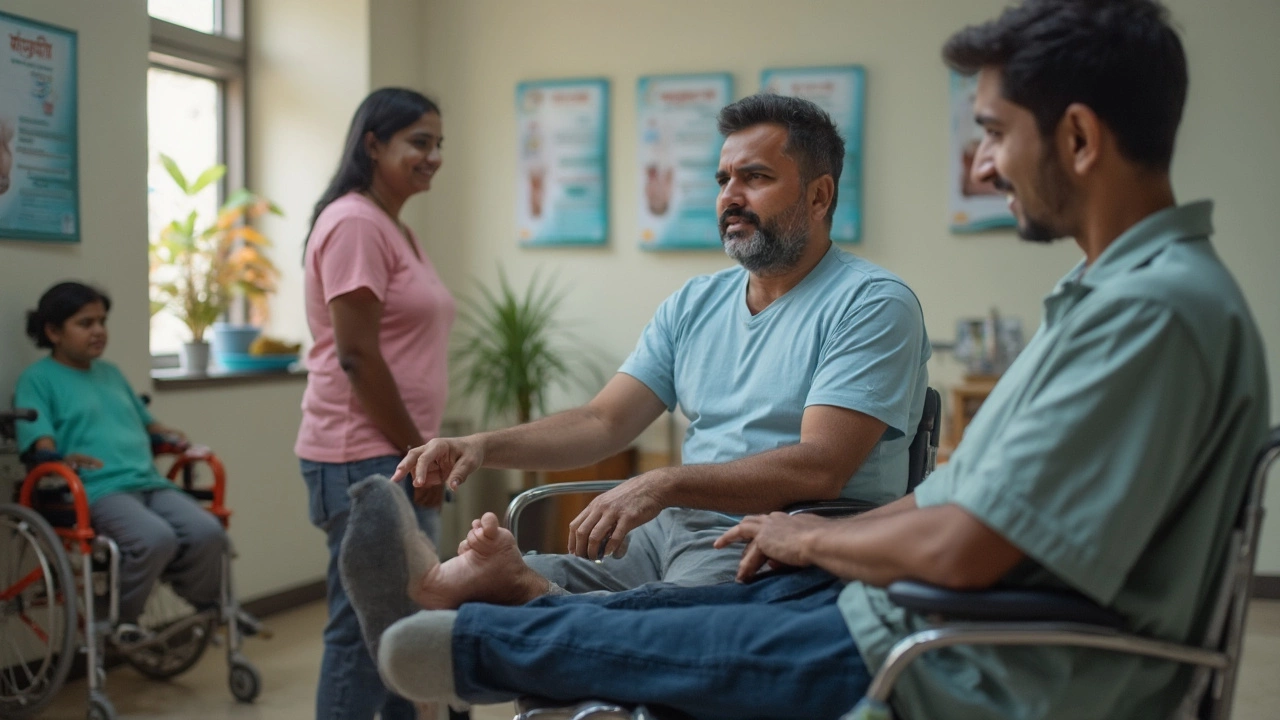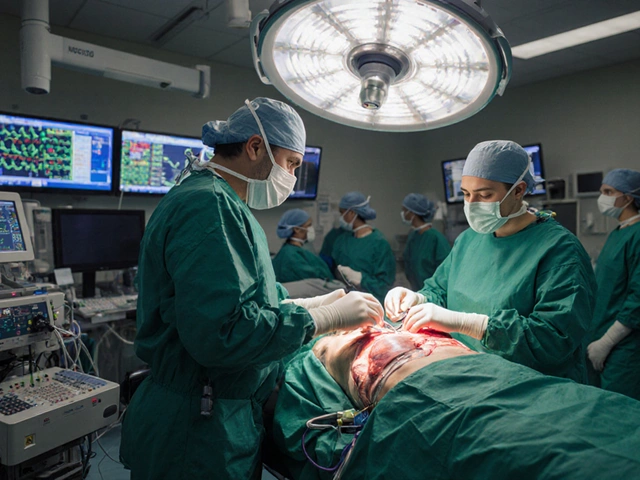- Home
- ::
- Knee Replacement Recovery Time: What to Expect After Surgery

Knee Replacement Recovery Time: What to Expect After Surgery
The recovery after a full knee replacement isn’t as simple as fixing a squeaky hinge. Most people want to know: how soon will I walk, drive, sleep normally, or even climb stairs again? A full knee replacement is a big deal for your body. Right after surgery, you'll probably wake up with a bandaged knee and a nurse gently telling you to wiggle your toes. This isn’t just a polite suggestion—it actually helps prevent blood clots.
The first steps usually happen within 24 hours. Sounds wild, but most people are on their feet (with help) in the hospital, using a walker or crutches. It won’t feel graceful—think zombie shuffle, not marathon runner. But moving early keeps swelling down and muscles firing. Expect the hospital stay to last two to three days if there aren’t any surprises. Once you’re home, recovery shifts into the slow-and-steady phase. Your new knee needs time and training to get comfy with everyday moves again.
The biggest tip: patience is your friend. If you expect to sprint up stairs in a week, you’ll be frustrated. But with every bit of progress—first steps, first shower, first pain-free night—you’re closer to getting your life (and mobility) back on track.
- What Happens Right After Knee Replacement?
- Timeline: Weeks, Months, and Milestones
- Tips for a Smoother Recovery
- When Can You Get Back to Normal Life?
What Happens Right After Knee Replacement?
Right after a knee replacement, you wake up in the recovery room with a big bandage on your knee and some tubes, probably an IV and maybe a drain to collect fluid. You might notice your leg feels heavy or numb at first—that’s the meds still working from surgery.
Nurses check your blood pressure, pulse, and ask about your pain (a lot). Pain meds kick in before it gets bad, and you’ll get blood thinners to help prevent clots. Nurses may also put compression boots or special socks on you for the same reason.
Here’s what usually happens in the first 24-48 hours:
- Moving fast—literally: Physical therapy generally starts on the same day or next morning. A therapist helps you sit, stand, or even take a few steps—yes, with a walker or crutches, even if you feel shaky.
- Swelling is normal: Expect your knee to swell up like a balloon. That’s because surgery irritates tissue, but ice packs and keeping your leg elevated help fight swelling and pain.
- Tubes and tech: You might have a blood drain or a catheter, especially if moving is tough at first. These disappear quickly, usually within a day or two.
- Vitals on repeat: Hospital staff will keep checking your temperature, pulse, and wound site for infection or bleeding.
Most people spend two to three days in the hospital after knee surgery. Check out these typical recovery stats:
| Day After Surgery | What Usually Happens |
|---|---|
| Day 0 | Wake up, start moving toes & foot, maybe stand with help |
| Day 1 | Physical therapy begins; sitting, standing, and a few steps |
| Day 2 | Tubes usually out, walking a short distance with aid |
| Day 3 | Move more freely, sometimes ready for release home |
One thing to remember: early movement is key for knee replacement recovery. It sounds tough, but the sooner your body gets moving, the less likely you’ll have complications like clots or tight muscles. Listen to your team—they’ve seen every type of recovery, from slow-starters to surprise sprinters. Your journey is unique, but these early steps lay the groundwork for everything that comes next.
Timeline: Weeks, Months, and Milestones
Everyone hopes for a quick bounce-back after a knee replacement recovery, but the truth is, this journey happens in stages. Here's how recovery usually plays out, week by week and then month by month. Surprises are rare—most people follow a pretty standard timeline unless there are complications.
- First Week: Walking with a walker or crutches, focusing on short, safe steps. Swelling and pain are still high, so ice packs and meds are your new best friends. A physical therapist will guide you through simple movements to get your joint working.
- Weeks 2-4: You'll probably swap the walker for a cane as balance gets better. Most people hit the "walking around the house" stage now—long strolls outside can wait. Bending your knee past 90 degrees is the goal, so keep stretching and following your exercise plan even when it's tough.
- Weeks 4-8: This is when you start noticing real improvements. Swelling and bruising are way down, and many folks return to driving if they're off strong painkillers and can bend their knee enough. You might do longer walks, light household chores, or even climb stairs (slowly!).
- Months 2-3: Most people can ditch the cane, return to social activities, and do daily routines without much help. Full strength isn't back yet, but your knee is far less stiff. If you work at a desk job, you might be back around this time—heavy labor jobs usually need more healing.
- Months 4-6: You've probably hit 90% of your healing by six months. If you're into golf, gardening, or swimming, now's when things start to feel less clumsy. But kneeling and deep squats? Those might still be tricky, and that's normal.
- 1 Year: This is the true finish line for most people. Your knee may still have occasional soreness or stiffness, especially when the weather shifts, but you should be moving well—enough for travel, hobbies, and family life.
Check out this ballpark timeline with some average milestones after knee replacement recovery:
| Time Point | Milestone |
|---|---|
| Within 1 Week | Walking short distances with walker |
| 2–4 Weeks | Walking indoors with cane, increased knee bend |
| 4–8 Weeks | Driving again, light chores |
| 2–3 Months | Most daily activities are back |
| 6 Months | 90% recovery, light sports possible |
| 1 Year | Full recovery for most people |
One solid tip: your own progress might look a little different. Some folks heal fast, others take longer—it depends on your age, overall health, and how hard you work at rehab. But if you stick with the plan, those first wobbly steps really do lead you back to normal life after a knee replacement recovery.

Tips for a Smoother Recovery
Getting the best out of your knee replacement recovery comes down to what you do after you leave the hospital. It's not just lying in bed and waiting for magic. Every small habit can make a big difference, especially in those first few weeks and months.
Stick to these proven moves to help ease swelling, avoid setbacks, and speed up your return to daily life:
- Follow your physical therapy routine like it’s your job. The exercises may feel boring or tough, but studies show people who do their daily stretches and strength moves tend to walk better and recover faster.
- Ice and elevate your knee several times a day. This simple routine can help cut pain and keep swelling in check. Some doctors suggest 20 minutes of ice, three to five times daily, especially during the first two weeks.
- Don’t skip your pain meds early on. If your pain is controlled, you’ll move more—and moving helps the joint heal.
- Watch for signs of infection. Redness, fever, or unusual swelling around the knee can be early warning signs. If you spot them, don’t wait—call your doctor.
- Eat healthy and stay hydrated. Protein, vitamins, and enough water can give your body the raw materials to rebuild tissue and fight off infection.
- Set small, realistic goals week by week. Something simple like bending your knee a little more or walking a few extra steps keeps you motivated.
One cool fact: Some physical therapists use a measurement called the "Timed Up and Go" test to spot improvements. If you can stand up from a chair, walk three meters, and sit back down under 12 seconds at the four-week mark, you’re ahead of the game.
| Stage | What to Expect |
|---|---|
| First 3 days | Stand and walk with help, start gentle exercises |
| Week 2 | Stitches or staples out, walk with cane or walker |
| 4-6 weeks | Wean off walker, increase exercise and mobility |
| 3 months | Most daily activities feel easier, return to light exercise |
| 6-12 months | Full strength and flexibility, pain mostly gone |
Remember, every recovery has bumps but sticking to these tips helps you get past them faster. Always check with your surgeon or physical therapist if something feels off, but trust your body’s small wins—they add up to big results.
When Can You Get Back to Normal Life?
This is the big question everyone asks right after knee replacement recovery starts rolling. Let’s get straight to it: most folks are back to doing light daily tasks around 6 weeks after surgery. By three months, a ton of normal activities feel possible, but your knee might still have some stiffness or random aches. Not everyone heals at the same speed—age, fitness, and how well you stick with rehab play a big role.
Here’s what you can usually expect for common stuff:
- Walking without aids (cane or walker): About 4–8 weeks, but some need longer, especially if you’re older or had problems before surgery.
- Driving: Safe for most people at 4–6 weeks (for your right knee—it can be sooner for your left if your car’s automatic), but only if you can control the pedals and aren’t on heavy pain meds.
- Going back to office work: Usually after 4–6 weeks, if your job isn’t super physical.
- Climbing stairs: You’ll most likely manage this with a handrail at 4–6 weeks but don’t expect to run up them yet.
- Sports or harder stuff (hiking, tennis): Wait at least 3–6 months, sometimes up to a year. Your doc and physio will have the final say here.
For heavy manual jobs, squatting, or kneeling on the new knee, it could be 6 months or more—some people never kneel comfortably after surgery. Most can handle low-impact workouts like cycling or swimming after 8 weeks. If you owned a dog before the op, walking it around the block might take about 6 weeks (as long as your pooch isn’t a wild puller).
| Milestone | Average Time |
|---|---|
| Walking without aids | 4-8 weeks |
| Driving again | 4-6 weeks |
| Return to office work | 4-6 weeks |
| Back to sports | 3-6 months |
One important tip: don’t judge your knee replacement recovery based on what your neighbor says about their cousin. Everyone’s body is different. Listening to your doctor and pushing yourself (gently) in physio are what move you forward. Even after you get back to your "normal" routine, most people say the knee keeps feeling better for another year or even longer.

 Health and Wellness
Health and Wellness





Write a comment